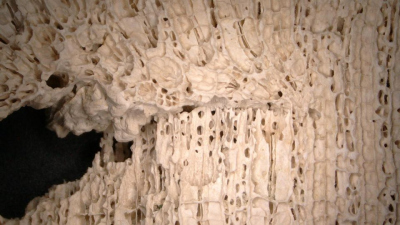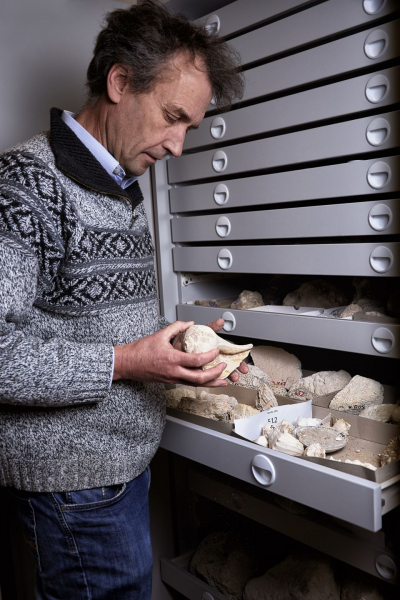- Home
- Discover
- Media Releases
- Media Releases 2022
- Korallenarchiv
Corals as climate archives

In the Middle Eocene, some 40 million years ago, a tropical climate prevailed in our latitudes: It was warm and humid, as evidenced by fossils from Lake Geiseltal near Halle, for example. It was so warm, in fact, that coral reefs extended far to the north – to about the 45th degree of latitude, roughly the level of present-day southern France. Some of these tropical reef corals are now fossils in Leipzig University's Geological and Palaeontological Collection. They come from the Paris Basin, a large marine bay that extended into what is now France. Among these fossils, Professor Thomas Brachert and his team found some very special corals: They were not fossilised like many others, but escaped this process. "This makes them a wonderful environmental archive. A coral skeleton grows every year much like a tree. But what is special about it is that the skeleton is something of an archive of several hundreds to a thousand years of climate history," said Professor Thomas Brachert from the Institute of Geophysics and Geology at Leipzig University.
Skeleton reveals small seasonal temperature fluctuations
The geologist and his team took samples from the coral's calcareous skeleton and analysed the material using geochemical methods. Based on the chemical properties, the scientists were able to deduce the temperature of the water in which the corals lived. The ratio of oxygen isotopes in the samples showed that the seasonal temperature differences were very small for this latitude. They correspond to about half of the current value of 15 degrees Celsius difference between seasons. "This means that our study confirms what had been expected but could never be measured so well: The fact that there were very small seasonal differences in the planet’s warm periods," says Brachert.
Such unique coral archives are also the subject of the new Priority Program "Tropical Climate Variability and Coral Reefs" (SPP 2299), which is coordinated by co-author Dr. Thomas Felis from MARUM - Center for Marine Environmental Sciences at the University of Bremen. In the collaborative project, which is funded by the German Research Foundation (DFG) in the coming years, researchers from various German universities as well as Helmholtz centers, Max Planck and Leibniz institutes will provide an ultra-high resolution perspective from the past into the future on current rates of change to project how tropical climate variability and coral reef ecosystems will change in a warming world, Felis describes.
Study data to improve current climate calculations
The research team's data not only allows conclusions to be drawn about the climate in the Middle Eocene: it can also be used to improve current climate models. "We can use our new findings about extreme warm periods as a comparison for the future. Our current computer models are based on assumptions that are not necessarily all correct. On the basis of our data, we can make assessments of the extent to which these models provide useful results," summarised Professor Thomas Brachert. This is also the starting point for the DFG's priority program.
Contact:
Dr. Thomas Felis
MARUM – Center for Marine Einvironmental Sciences, University of Bremen
Phone: +49 421 - 218 65751
Email: [Bitte aktivieren Sie Javascript]
Original publication:
"Slow-growing reef corals as climate archives: A case study of the Middle Eocene Climatic Optimum 40 Ma ago", DOI: 10.1126/sciadv.abm3875
More informationen:
Priority Program „Tropical Climate Variability and Coral Reefs" (SPP 2299)



